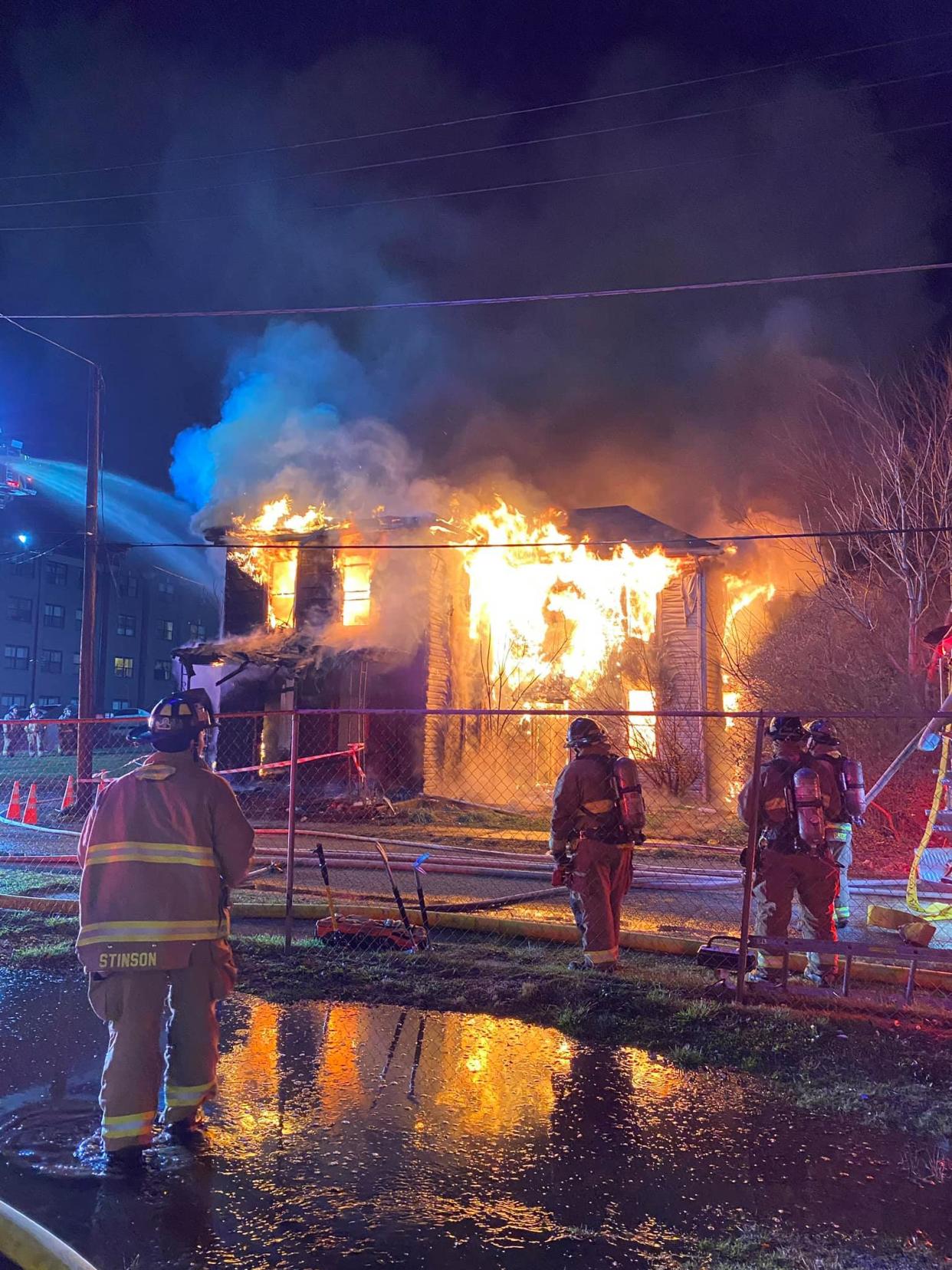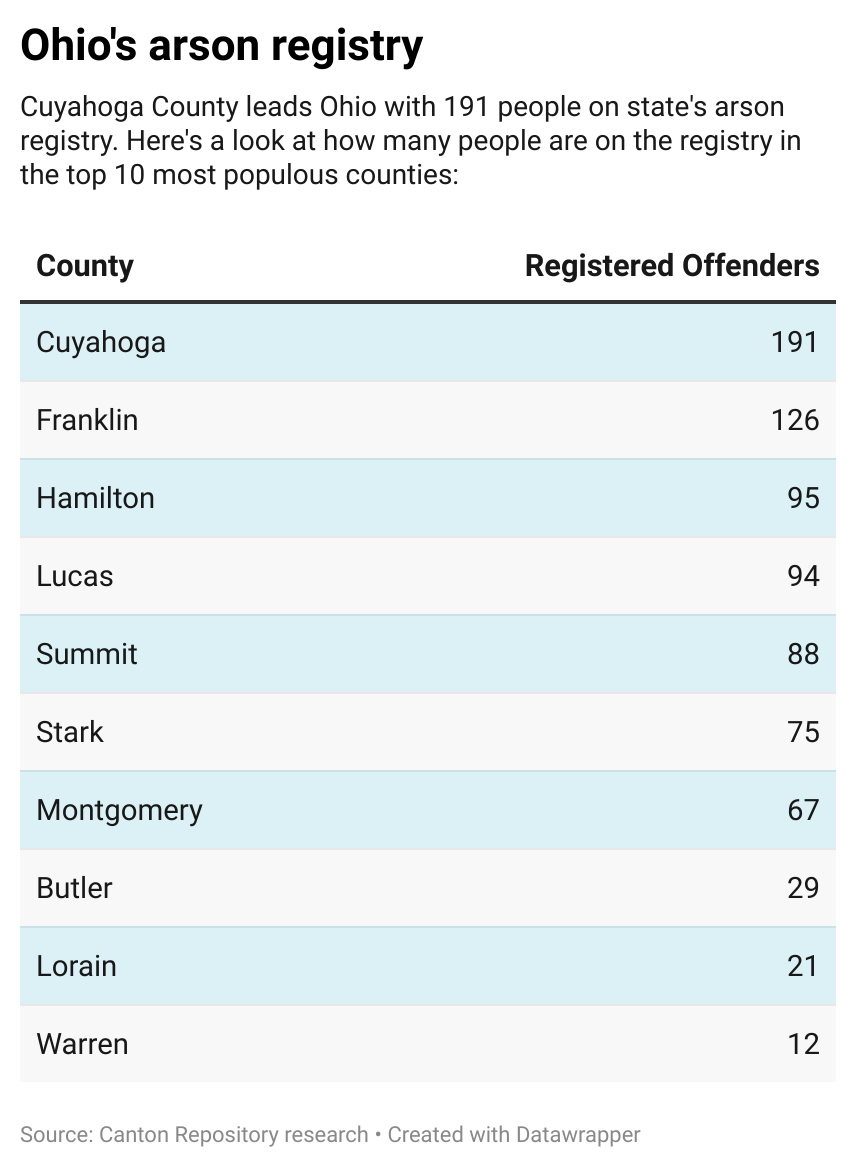Ohio's arson registry just turned 10 years old. Is it working?

Shawndra Brown decided to set a car on fire following a domestic dispute.
That was in 2013. As part of her sentence, the 35-year-old Columbus resident was required to register once a year, every year, as an arson offender — her name becoming one of the first to appear on Ohio's arson registry database.
“I can’t say it’s unfair because we did commit a crime,” Brown said. “I just think the terms of it can be a bit excessive.”
As Ohio's arson registry turns 10 years old, the debate continues over whether it's an effective program or it violates constitutional rights, a question that is now pending before the Ohio Supreme Court. The state launched the registry in July 2013 as a tool for arson investigators, modeling the program after a similar database for sex offenders. The assumption was that people caught setting fires may do so again.
At the time, state officials said they weren’t sure how many arsonists were living in Ohio. Today, there are 1,377 individuals registered as arson offenders in the state. But it's unclear how many of those are repeat offenders, as the Ohio Bureau of Criminal Investigation, which maintains the statewide database, says it doesn't keep track of whether those on the registry are arrested again.
In Brown's case, she failed to register — which she attributes to a misunderstanding — and is now being held in state prison.
"I have to deal with this, not just for this year, but for the rest of my life," she said.
How does the Ohio arson registry work?
Under the law, anyone convicted of an arson crime or who was in prison for arson at the time the law took effect has to register with his or her county sheriff.
Convicted arsonists must pay $50 for their initial registration and after that, $25 annually. All fees go to the Ohio Attorney General's BCI for maintenance of the database.
Unlike the sex offender registry, the arson registry is not a public record. The only people who can access the database are fire officials and law enforcement.
BCI declined to provide a county-by-county breakdown of offenders, but The Canton Repository contacted the sheriff's offices in Ohio’s 10 most-populated counties. Cuyahoga County had the most registered with 191, followed by Franklin (126), Hamilton (95), Lucas (94), Summit (88), Stark (75), Montgomery (67), Butler (29), Lorain (21) and Warren (12).
Anyone who fails to register could be charged with a fifth-degree felony, just like Brown.

Pros: A valuable investigative tool
As arson investigators arrive at a crime scene, they are left with little evidence to work with.
Joshua Hobbs, the state fire marshal's fire and explosion investigations bureau chief, said investigators do what they can to solve a crime after the scene has been destroyed by flames.
At that point, any tool is valuable, including the registry. Here's how investigators use the registry:
Identify a pattern of intentionally set fires within a community.
Search the registry for offenders residing within the area.
Approach these offenders with questions to see if they are involved or know any information about the crimes.

The database is geared toward habitual offenders. Canton Fire Captain Derek Paige said there have been many instances where re-offenders are arrested with help from the database. He was unable to provide any specific case details.
According to the BCI, the database does not keep track of how many times an offender is re-arrested for arson.
More: Ohio lawmakers pass bill to create arson registry
A public safety measure: 'It's all about information.'
Hobbs said he deals with eight to 10 instances of habitual fire-starters annually. Even though serial arsonists are not a large part of his investigative work, he reinforces the importance of the registry.
"I think [the registry] is beneficial, even if its impact is not overly significant," Hobbs said.
According to the BCI, out of 953 fire cases investigated in 2022, 197 were set intentionally.
"It's all about information," Paige said. "The arsonist registry is a good way of keeping information on people that could potentially do harm. If you're going to commit these types of crimes, it's not unreasonable to keep track."

More: Ohio to track convicted arsonists on new registry
Critic: Ohio's arson registry is a faulty database

David Licate, professor and department chair of the University of Akron's Criminal Justice Studies Department, said that common motivations for arson include crime concealment, insurance fraud or revenge crimes.
But most offenders are unlikely to start another fire after their first conviction. In fact, Licate estimates that arson recidivism rates are under 10%, rendering an arson registry unhelpful.
The Ohio Revised Code does not mention any classification of arsonists. Unlike the organized tier system of the sex offender registry, names on the arson registry are not categorized by severity of crimes.
Under the section, people convicted of arson are required to register for life unless a recommendation for a shorter period is made by a prosecutor or law enforcement agency.
Licate said that lifelong registration is likely to flood the database with irrelevant information: Hundreds of registered individuals who are unlikely to reoffend.
“Say it was one shot when they were 18 and they’re going to be on there for life," he said. “There is a very small portion of those people who are repeat offenders on that database.”
Ohio Public Defender Timothy Young describes the arson registry as a misuse of resources. He also notes lack of peer-reviewed studies that provide evidence of any criminal registry being effective in solving or preventing criminal activity.
"Sadly, I think registries make us feel better, but don't actually provide us any protections," Young said.
Testing the constitutionality: Tyree Daniel v. the State of Ohio
In October 2019, Tyree K. Daniel set fire to a commercial building in Toledo. There was no denying his guilt: Video footage showed him spraying lighter fluid onto the structure.
He was charged with two counts of aggravated arson, resulting in 60 days of jail time and three years of community control.
During his sentencing, Daniel was notified about the arson registry. His attorney argued that the law creating the registry was unconstitutional. The trial court objected to the argument.
Daniel persisted, bringing his argument to two other courts. The Sixth District Court of Appeals said the law was constitutional. The Fourth District Court of Appeals said it was unconstitutional.
Now, Daniel’s case has reached the Ohio Supreme Court. The state law allows a judge to reduce an arson registration from life to 10 years, but only if the prosecutor and law enforcement agency involved recommend the reduction.
Daniel's attorneys argue this is a separation of powers issue. In order for any change to be made to his sentencing, the executive branch (law enforcement) must make a recommendation to the judicial branch (the trial judge).
The Office of the Ohio Public Defender submitted a brief in support of Daniel’s position.
The Supreme Court has yet to rule in the case.
Cons: Creation of a new crime
Brown has been incarcerated in a state prison for nearly a year after committing arson registration violation. Now, she feels that she is facing the consequences of her 2013 crimes all over again.
Young said this charge is proof that the arson registry causes harm. Instead of rehabilitating arsonists, the registry creates a new charge for offenders who fail to re-register.
“Not putting your name on a list is a crime," he said. "I think that is the real evidence of the harm of registries. We are not preventing crime. We are creating crime.”
Brown’s regret? Misunderstanding the terms of the registry.
She said her failure to register was a result of confusion. She had no information to update on the registry – no address change, no new vehicles. She thought because all her information was up to date, there was no need to re-register.
Brown said she did not receive any type of warning to register leading up to her most recent arrest.
What's next? Officials share their opinion on the future of the arson registry
Young said changes should be made. He suggests an elimination of criminal registries all together.
“Let’s use resources in a way that actually help people heal and spend money in ways that we can find measurable outcomes,” he said.
On the other hand, Paige of the Canton Fire Department said other states could learn a lesson from Ohio's arson registry, creating safer communities across the nation.
“I think other states could model off what we do in Ohio and implement it,” Paige said. “To me, this is just another requirement for registration that is beneficial to the public in general.”
Licate of the University of Akron recommends a balance of civil liberties and public safety. With a lack of research and evaluation of the arson registry and its effectiveness, he posed these questions with hopes they will be answered in the near future: “What is the goal of this data base? What are the outcomes? Is it actually reducing repeat offending in arson?”
Contact Abreanna Blose by email at ablose@gannett.com or by phone at 330-580-8513.
This article originally appeared on The Repository: Ohio's arson registry turned 10 years old: Is it effective?

